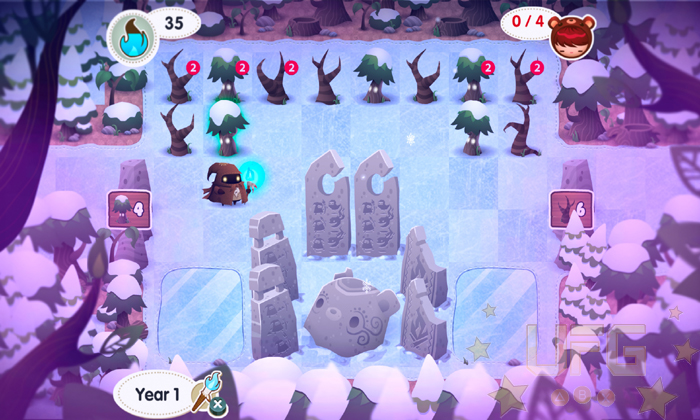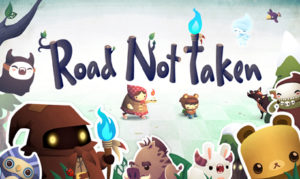UFG Goes Hands On With Road Not Taken!
I’ve played my fair share of puzzle games. This includes everything from your traditional puzzle games like Tetris and Bejeweled to more action ordinated ones like Catherine and Portal. That said, I’ve never seen anything quite like Spry Fox’s Road Not Taken. It originally caught my eye because of its inclusion of rouge-like elements; I expected it to be a one-of-a-kind experience. After playing an early build of the game, I can say that it’s definitely a unique take on the puzzle genre!
In Road Not Taken you take control of a ranger tasked rescuing lost children that went missing after a terrible snowstorm hit during the yearly harvest. Where the story goes from there is really up to you, but more on that later. The gameplay is what takes center stage early on. Once you’ve ventured into the forest to find the children, you’ll be greeted with your first puzzle filled level. Each one consists of multiple rooms/areas with grid-like floors that are adjacent to one another. Though they were connected, they also were separate places within the forest; the screen would focus on one area at a time. Think of it like the original Legend of Zelda and how the rooms found in dungeons would slide across the screen as you traveled. Each area also housed different items, NPC’s, and creatures that need to be used/avoided before a kid can be found.
The idea is to solve the puzzle (or puzzles) within each area by manipulating different items in order to rescue the missing children. Of course, there are different mechanics at play that makes this task difficult. For starters, moving items around each area is tricky. You see, the ranger moves items by standing next to them and picking them up with what seems to be telekinesis; he doesn’t actually touch them, rather they float by his side. Wherever the item is located in relation to his position when picked up, will stay there until dropped. So if you pick up an item that is above his head, it will stay there when moving around.
Releasing the object will send it flying a certain distance before landing (usually across the entire screen and possibly into the next room). The way the puzzles are solved is by tossing an object towards another object to achieve a desired effect. In an effort to be less vague, let me give you an example. Picking up an axe and placing it next to a tree will create chopped wood. The wood may be needed to start a fire, which happens to be the puzzle’s requirement to open a door. Or maybe placing four items next to one another will cause something else to happen in another room. The tricky part comes in the fact the ranger will pick up all nearby items whenever you press the grab button. It can be difficult to solve a puzzle where the solution is the proper placement of items, when you keep accidentally moving the wrong items in the process.
When there’s a crowded room, the movement of required items can definitely provide a challenge. Thing get tougher whenever the ranger in dark areas though. Whenever there isn’t sunlight or a fire, moving items around causes him to lose health. Then there are the unfriendly forest dwellers (bears, wolves, spirits, etc.) that are out to harm you and the children. What’s interesting is that they don’t move unless you do; each time you take a step, they take one. So, the game does give you time to scope out your surroundings and plan what to do upon entering a new area. That doesn’t mean the puzzles are easy, just that you can breathe a little before moving forward.
Getting through any stage is difficult with all the things you have to think about. This is especially true when considering the consequences of doing poorly. Being a rogue-like game where death is permanent, the wrong move will result in you going back to year (level) one. Not only that, but each level is procedurally made; so there’s no going back to that tricky puzzle for a second chance. The good news is that you don’t have to save all of the lost children to complete a level. As horrible as that sounds, it brings up an important question. Do you try and save all the children or cut your losses and live to fight another day. Completing a year does grant you with rewards that could help you rescue more children in years to come. Depending on your performance (how many children you save) you earn resources such as rice, berries, copper, etc. Also, a percentage of the life you have at the end of a level is carried over to the next. Living to fight again doesn’t sound so bad…
Going back to the RPG elements, as you continue helping the town throughout the years, you’ll start to develop relationships. In the beginning the NPC’s won’t have much to say as you’re new to town. After a few years and saved children, that’ll change. As you build relationships and gain their trust, the townsfolk may give you items that adjust the difficulty of puzzles or resources you can use to help further your relationships with other NPC’s. These resources can also be used to make save points; donating to a certain fountain will allow you to just go back one year after death. Sounds good right? Of course, if you weren’t able to save someone’s kid, I doubt they’ll be willing to befriend you.
I was really intrigued by the atmosphere in Road Not Taken. The juxtaposition of the cartoony art style and the dark theme involving lost children is really interesting. The same goes for other aspects of the game. The charmingly upbeat music played in town is a stark contrast to the eerie tones found in the forest. The dialog from NPC’s could be cheerful or sad depending on how their life’s been since the storm. And the spirits dialog in the forest is just plain dark – though nothing really pulled my heartstrings, there were plenty of emotional highs and lows during my journey. At least not from years 1-5 (the levels I’m allowed to talk about). I have to say I’m pretty excited to see what changes will happen with the full game. The puzzles and rouge elements along with the relationship building kept me entertained for some time.
There were some minor issues like some lag at certain times which could cause you some damage for moving too much and frequent crashes. This was an early build though, so I’m pretty sure those issues will be worked out in time. All and all, if you’ve been waiting for a new, interesting puzzle game, Road Not Taken could be it. Even if you weren’t looking for such a game, I’d recommend at least keeping an eye out for our review. You never know what gems you’ll find in an indie title!


